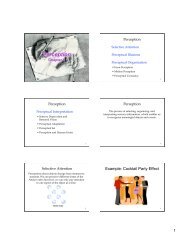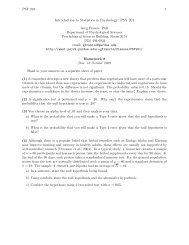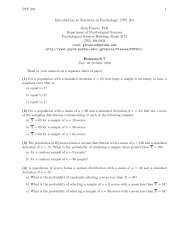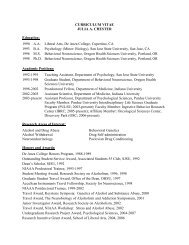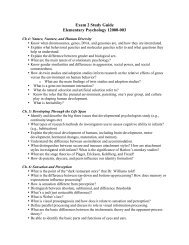Social Psychology in Film - Psychological Sciences
Social Psychology in Film - Psychological Sciences
Social Psychology in Film - Psychological Sciences
Create successful ePaper yourself
Turn your PDF publications into a flip-book with our unique Google optimized e-Paper software.
<strong>Social</strong> <strong>Psychology</strong> <strong>in</strong> <strong>Film</strong><br />
Psy 392F Honors Only<br />
Spr<strong>in</strong>g Semester, 2006<br />
Instructor: Professor Kipl<strong>in</strong>g D. Williams, PSYC 2165<br />
E-mail: kip@psych.purdue.edu<br />
Webpage: http://www.psych.purdue.edu/~kip/<br />
Course Webpage: http://www.psych.purdue.edu/~kip/392F/<strong>in</strong>dex.htm<br />
Class times: Tuesdays, 6:00pm – 8:50pm; PRCE 277<br />
Office hours: Thursdays: 9:30 a.m. – 12 or by appo<strong>in</strong>tment.<br />
Texts: No text; assigned read<strong>in</strong>g to be handed out the week before paper is due.<br />
In this course, we exam<strong>in</strong>e current cutt<strong>in</strong>g-edge theory and research <strong>in</strong> experimental social psychology and use popular<br />
(and some that are not so popular) films to assist <strong>in</strong> provok<strong>in</strong>g thought and analysis of the theory and research.<br />
Aims. This course is different from most. I’m not <strong>in</strong>terested <strong>in</strong> how well you remember material, but I am <strong>in</strong>terested <strong>in</strong><br />
how well you th<strong>in</strong>k and <strong>in</strong> how well you articulate your ideas.<br />
Structure. Each week, read<strong>in</strong>gs (journal articles, chapters) will be assigned. We will view a film that has some conceptual<br />
relation to the read<strong>in</strong>g topic. Your thought paper, due at 4pm the day before the class meet<strong>in</strong>g, should be sent to me<br />
with<strong>in</strong> an email (not as an attachment). Your paper should support a thesis of your choice (I will be giv<strong>in</strong>g you advice as<br />
to how to write your papers). These papers can be no longer than 500 words <strong>in</strong> length. Late papers will not be accepted. You<br />
will receive feedback and a score for each paper (0-10) by class time, where we will discuss the papers and the film. New<br />
read<strong>in</strong>gs will be assigned, another film viewed, and so on.<br />
Grad<strong>in</strong>g. I will grade each paper from 1 (not so good) to 10 (excellent). Although thirteen papers and films will be<br />
assigned, you are only required to write six of them. If you write seven or more papers, the six papers with the highest<br />
scores will be counted. Whether you write the paper or not, you are expected to read the assigned paper(s), view the<br />
film, and take part <strong>in</strong> the discussion. Class participation will be taken <strong>in</strong>to account for borderl<strong>in</strong>e grades. Course marks<br />
will be based on the five papers (80%), and attendance/class participation (20%).<br />
Purdue's standard grad<strong>in</strong>g policy will be used to assign f<strong>in</strong>al letter grades:<br />
100 – 90% = A<br />
89 - 80% = B<br />
79 - 70% = C<br />
69 - 60% = D<br />
< 60% = F<br />
Purdue Student Code of Honor: Know it and follow it. For your own sake, do your own work. Plagiarism is a serious<br />
offense, and is easily detectable with the advent of search eng<strong>in</strong>es. Here is a useful website to understand the def<strong>in</strong>ition<br />
and issues surround<strong>in</strong>g plagiarism: http://owl.english.purdue.edu/handouts/research/r_plagiar.html<br />
Exceptions. Some films conta<strong>in</strong> nudity, offensive language, and/or violence. If you feel that a selected film is personally<br />
objectionable, then please see me about select<strong>in</strong>g an alternative film (and you can view this on your own).
Williams—Psy 392F - <strong>Social</strong> <strong>Psychology</strong> <strong>in</strong> <strong>Film</strong> 2<br />
Date Read<strong>in</strong>g <strong>Film</strong><br />
Jan 10 Organizational meet<strong>in</strong>g<br />
Jan 17 MacDonald, G., & Leary, M. (2003). Why does social<br />
exclusion hurt? The relationship between social and somatic<br />
pa<strong>in</strong>. <strong>Psychological</strong> Bullet<strong>in</strong>.<br />
Eisenberg, N. I., Lieberman, M. D., & Williams, K. D. (2003).<br />
Does rejection hurt? An fMRI study of social exclusion.<br />
Science, 302, 290-292.<br />
AN ANGEL AT MY TABLE (1990) C-158m. D:<br />
Jane Campion. A: Kerry Fox, Alexia Keogh, Karen<br />
Fergusson, Iris Chum.<br />
Jan 24 No class No class<br />
Jan 31 Florian, V., Mikul<strong>in</strong>cer, M., & Hirschberger, G. (2002). The<br />
anxiety-buffer<strong>in</strong>g function of close relationships: Evidence<br />
that relationship commitment acts as a terror management<br />
mechanism. Journal of Personality and <strong>Social</strong> <strong>Psychology</strong>, 82, 527-<br />
542.<br />
Feb 7 Greenwald, A. G. (1980). The totalitarian ego. American<br />
Psychologist, 35, 603-618.<br />
Feb 14 Snyder, M., & Stukas, A. A. (1999). Interpersonal processes:<br />
The <strong>in</strong>terplay of cognitive, motivational, and behavioral<br />
activities <strong>in</strong> social <strong>in</strong>teraction. Annual Review of <strong>Psychology</strong>, 50,<br />
273-303.<br />
Feb 21 Ellemers, N., Spears, R., & Doosje, B. (2002). Self and social<br />
identity. Annual Review of <strong>Psychology</strong>, 53, 161-186.<br />
Feb 28 Langlois, J. H., Kalakanis, L., Rubenste<strong>in</strong>, A. J., Larson, A.,<br />
Hallam, M., & Smoot, M. Maxims or myths of beauty? Metaanalytic<br />
and theoretical review. <strong>Psychological</strong> Bullet<strong>in</strong>, 126, 390-<br />
423.<br />
Mar 7 Penner, L. A., Dovidio, J.F., Piliav<strong>in</strong>, J.A., & Schroeder, D.A.<br />
(2005). Prosocial behavior: Multilevel perspectives. Annual<br />
Review of <strong>Psychology</strong>.<br />
AI (Artificial Intelligence) (2001) C-145m. D: Steven<br />
Spielberg. A: Haley Joel Osment, Jude Law, Frances<br />
O’Connor, William Hurt.<br />
RASHOMON (1950) B/W-85m. D: Akira Kurosawa.<br />
A: Toshiro Mifune, Machiko Kyo, Masayuki Mori,<br />
Takashi Shimura.<br />
BEING THERE (1979) C-130m. D: Hal Ashby. A:<br />
Peter Sellers, Shirley MacLa<strong>in</strong>e, Melvyn Douglas, Jack<br />
Warden.<br />
EUROPA EUROPA (1990) C-112m. D: Agnieszka<br />
Hollan. A: Marco Hofschneider, Julie Delpy, René<br />
Hofschneider.<br />
SHREK (2001) C-88m. D: Andrew Adamson, Vicky<br />
Jenson. V: Mike Myers, Eddie Murphy, Cameron Diaz.<br />
HOTEL RWANDA (2004) C-121m. D: Terry George.<br />
A: Don Cheadle, Nick Nolte, Xolan Mali, Desmond<br />
Dube, Hakeem Kae-Kasim, Fana Mokoena.<br />
Mar 14 Spr<strong>in</strong>g Break Spr<strong>in</strong>g Break<br />
Mar 21 Hewstone, M., Rub<strong>in</strong>, M., & Willis, H. (2002). Intergroup bias.<br />
Annual Review of <strong>Psychology</strong>, 53, 575-604.<br />
Mar 28 Steele, C. (1997). A threat is <strong>in</strong> the air: How stereotypes shape<br />
<strong>in</strong>tellectual identity and performance. American Psychologist, 52,<br />
613-629.<br />
Apr 4 Dovidio, J. F., & Gaertner, S. L. (2004). Aversive racism.<br />
Advances <strong>in</strong> Experimental <strong>Social</strong> <strong>Psychology</strong>, Vol.36 (pp. 4-56). NY:<br />
Academic Press.<br />
Apr 11 Wood, W. (2000). Attitude change: Persuasion and social<br />
<strong>in</strong>fluence. Annual Review of <strong>Psychology</strong>, 51, 529-570.<br />
Apr 19 Fitness, J. (2001). Betrayal, rejection, revenge, and forgiveness.<br />
In M. R. Leary (Ed.), Interpersonal rejection (pp. 73-104)<br />
Apr 25 Anderson, C. A., & Bushman, B. J. (2002). Human aggression.<br />
Annual Review of <strong>Psychology</strong>, 53, 27-51<br />
AUSTRALIAN RULES (2002) C-95m. D: Paul<br />
Goldman. A: Nathan Phillips, Luke Carroll, Lisa<br />
Flanagan, Tom Budge.<br />
THE BELIEVER (1975) C-98m. D: Henry Bean. A:<br />
Ryan Gosl<strong>in</strong>g, Summer Phoenix, Billy Zane, Theresa<br />
Russell.<br />
CRASH: (2004) C-122m. D: Paul Haggis. A: Don<br />
Cheadle, Matt Dillon, Jennifer Esposito, Thandie<br />
Newton, Sandra Bullock, Brendan Fraser.<br />
12 ANGRY MEN (1957) B/W-95m. D: Sidney Lumet.<br />
A: Henry Fonda, Lee J. Cobb.<br />
LANTANA (2001) C/B&W-121m. D: Ray Lawrence.<br />
A: Anthony LaPaglia, Geoffrey Rush, Barbara Hershey,<br />
Kerry Armstrong.<br />
BOWLING FOR COLUMBINE 1975) C-125m. D:<br />
Michael Moore. (Documentary) A. Charlton Heston,<br />
Marilyn Manson, Matt Stone.
Williams—Psy 392F - <strong>Social</strong> <strong>Psychology</strong> <strong>in</strong> <strong>Film</strong> 3<br />
How to Write Your 2-Page Thought Papers<br />
I realize that 500 words may seem unreasonably restrict<strong>in</strong>g to you, prevent<strong>in</strong>g you from adequately express<strong>in</strong>g your<br />
ideas. In scientific journals, psychology <strong>in</strong>cluded, writ<strong>in</strong>g is necessarily concise. Specific page restrictions are enforced.<br />
Redundancy, flowery writ<strong>in</strong>g, and ambiguity are to be edited out. This is a difficult exercise. Your first draft for each<br />
paper will probably be 3-4 pages long, so your subsequent draft(s) will <strong>in</strong>volve edit<strong>in</strong>g your paper down to size. (If, on<br />
the other hand, you’re hav<strong>in</strong>g a difficult time com<strong>in</strong>g up with 500 words, then you may not be putt<strong>in</strong>g enough thought<br />
<strong>in</strong>to your thought papers).<br />
You will then go through a thorough edit<strong>in</strong>g stage. Ask yourself these questions: Is this sentence necessary? Is this word<br />
necessary? Can I comb<strong>in</strong>e these two sentences? Am I stray<strong>in</strong>g from my ma<strong>in</strong> thesis?<br />
1) State your thesis early and explicitly. Underl<strong>in</strong>e it, so I know where it is (or italicize it or put it <strong>in</strong> ALL CAPS).<br />
2) Do not settle for a wishy-washy thesis. Be brave enough to take a stance and argue for it. Avoid the obvious<br />
(i.e., this movie is a perfect example of this phenomenon). I am look<strong>in</strong>g for clever <strong>in</strong>sights, particularly about the<br />
theory (or theories) and/or research (not so much about the film).<br />
3) Select a thesis with a narrow focus. It should be <strong>in</strong> some way an extension of the read<strong>in</strong>g (not the movie).<br />
Critically analyze the read<strong>in</strong>g. Take issue with the theory, the generalizations, or the way the idea was tested. Use<br />
the movie to help come up with your idea or to help illustrate your po<strong>in</strong>t.<br />
4) Do not necessarily select a thesis that is the central focus of the movie or the read<strong>in</strong>g. It could be a tangential<br />
issue that piqued your <strong>in</strong>terest.<br />
5) Support your thesis with persuasive arguments based upon examples from the read<strong>in</strong>g and the movie.<br />
6) Use each paragraph to make a po<strong>in</strong>t that will provide strength to your thesis. The po<strong>in</strong>t should be clear and the<br />
paragraph should be organized around it. Do not write a paragraph that drifts from one po<strong>in</strong>t to another to<br />
another. Just have one po<strong>in</strong>t per paragraph.<br />
7) Avoid quotes, especially long ones.<br />
8) Def<strong>in</strong>e important or esoteric terms. Do not assume I know what you are talk<strong>in</strong>g about.<br />
9) Remember that spell<strong>in</strong>g, grammar, sentence structure and organization ARE important and figure <strong>in</strong>to the<br />
grad<strong>in</strong>g.<br />
10) Do not end your paper with a platitude.<br />
Other tips:<br />
Some students need an <strong>in</strong>troductory sentence or two to get the ball roll<strong>in</strong>g, but these sentences can often be discarded<br />
before submitt<strong>in</strong>g the f<strong>in</strong>al draft.<br />
Often students talk about more than one thesis, which always results <strong>in</strong> a lower grade. There is not enough space to<br />
write and defend more than one thesis with<strong>in</strong> the 500-word limit. Choose your most provocative and well-argued thesis,<br />
and use the entire paper to elaborate upon it.<br />
I cut-and-paste your paper <strong>in</strong>to a word document, and the first th<strong>in</strong>g I do is get a word count. If your paper is over 500<br />
words, I stop read<strong>in</strong>g after I reach the 500 th word. Seriously. So, you should do a word count before submitt<strong>in</strong>g it., and<br />
make sure it is no more than 500 words.


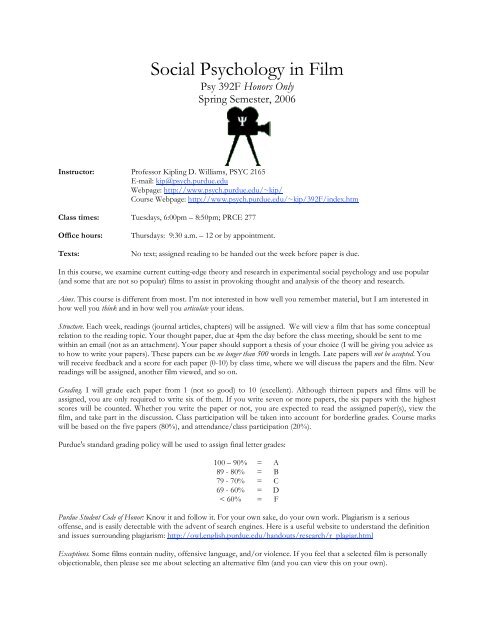
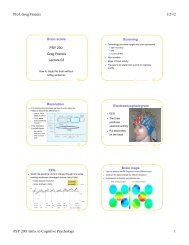

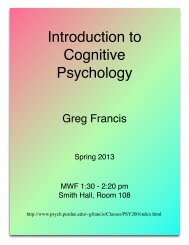
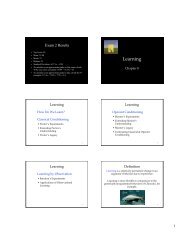
![Exam 4 Study Guide[1]](https://img.yumpu.com/45196739/1/190x245/exam-4-study-guide1.jpg?quality=85)
